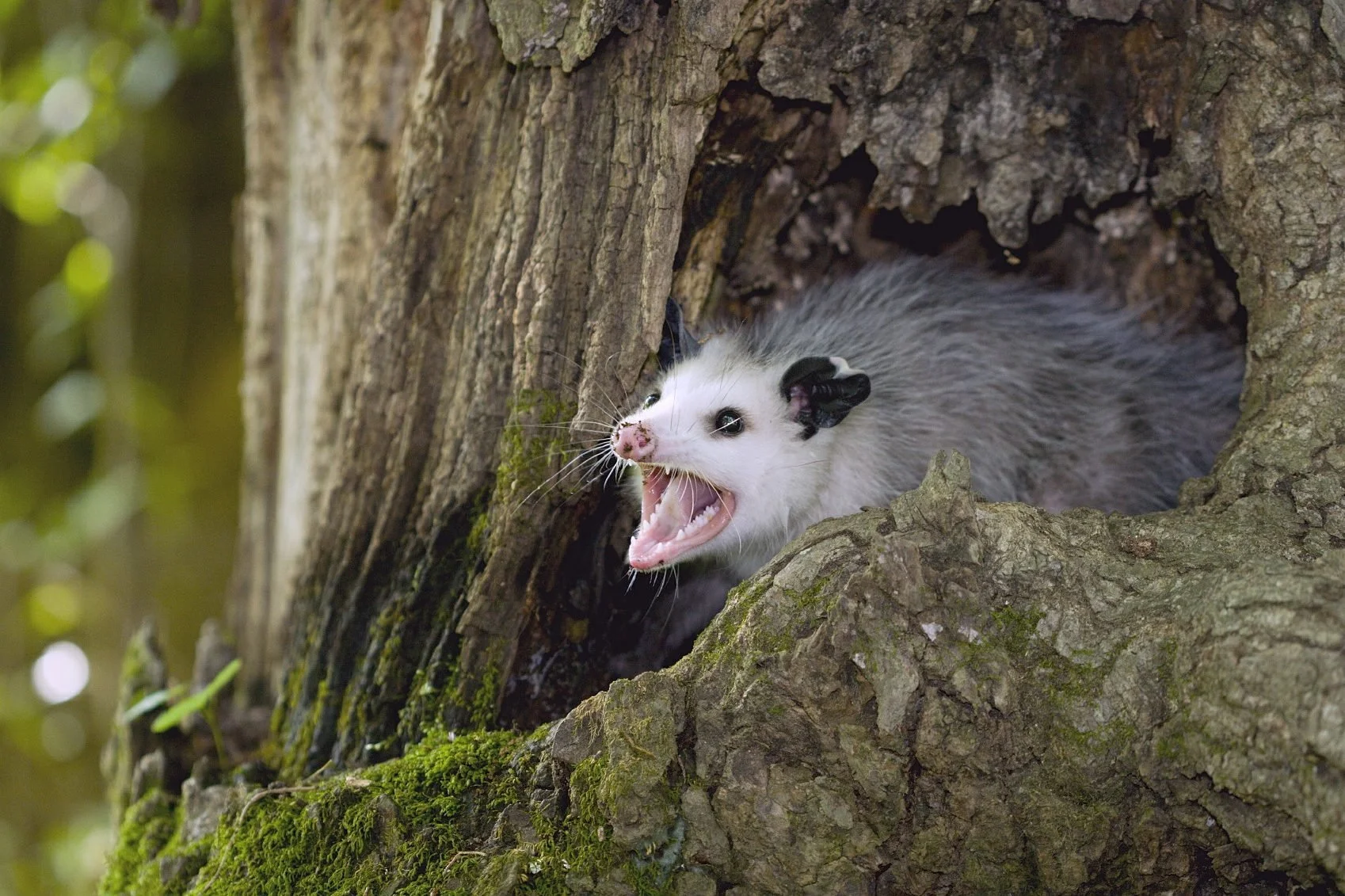Virginia Opossum
Scientific Name: Didelphis virginiana
Virginia opossums have stout bodies and short legs. They are grayish in color, but can have variations with red, brown, or blackish hues. They have long white-tipped guard hairs. The fur on their face is lighter than that on their body, usually white, cream or pale gray color.
They have large dark ears that are mostly hairless, dark eyes, and a pink nose. Their tail is long and hairless, making it prone to frost bite. They have prehensile tails and use them as an additional limb for climbing. They also have an opposable hallux (like a human thumb).
Adult size: 12 to 22 in
Weight: 4 to 13 lbs
Life span: 1 to 2 years on average
Maturity: 6 to 8 months
Litter size: 4 to 25 (many do not survive the climb to the pouch)
Fun Fact
You might already know that the Virginia opossum is the only marsupial in North America, but did you know that they have a lower body temperature than most mammals? This makes them less likely to contract diseases like rabies and other viruses.
Diet
Virginia opossums are extremely opportunistic feeders. These animals eat a variety of foods based on the season, their habitat and their range. Their diets include vertebrates, invertebrates, plant material, fruits, grains and carrion. During the colder seasons, small vertebrates tend to make up a larger portion of their diet, whereas in the warmer seasons, they consume more invertebrates, plant material, fruits and seeds.
Stomach content analyses have been conducted on Virginia opossums throughout the United States, generally their diet is composed of 14 to 27% mammal tissues, 10 to 18% fruits, seeds and bulbs, 6 to 11% grasses and leaves, 3 to 13.5% insects, 5.5 to 9% earthworms and 3 to 5% birds. Other food items were found more specific to an animal’s location and included up to 22.5% reptiles and amphibians, 10% gastropods, 9% pet food, 9% garbage and up to 5% carrion.
Habitat
Virginia opossums can be found in a wide variety of habitats, though they prefer to be near water sources. They can be found in forests, fields, woodlands and thickets, as well as in human occupied areas. The build nests in brush piles, hollow trees, and human structures.
Behavior
Virginia opossums are mostly solitary animals. They are primarily nocturnal and spend their nights on the ground, as well as in trees. They do not hibernate over the winter, though they may reduce their activity.
They are known for their defensive behavior in which they enter a catatonic state or “play dead.” This behavior is displayed most frequently in younger individuals. More commonly they will bare their teeth, stand their ground and hiss when they feel threatened. They will also flee to water or a tree to escape a threat.
Reproduction and Life Cycle
Virginia opossums are polygynous, in which males solicit multiple female names. Males have a scent gland on their chest that emits a musky odor during the breeding season. Females have a 30-day estrus cycle. This is the only time males and females interact. After mating, females resume their aggressive and solitary nature.
Breeding season varies geographically but is typically sometime between January and September. In northern regions, they may only produce one litter per year, while in warmer climates, they can produce up to 3 litters in a year. They have a very short gestation period, lasting about 12 days.
Offspring are born highly underdeveloped and must make the climb to their mother’s pouch where the rest of their development will occur. They remain in the mother’s pouch for 50-70 days. Young are typically weaned between 93 and 105 days old.
Population Status
Virginia opossums are highly adaptable to human altered habitats. Because of this, their populations are successful and widespread. They are listed as of “least concern” on the IUCN Red List.
Viewing
Virginia opossums may be more difficult to spot since they are primarily nocturnal. They prefer hanging out in farmlands, wooded lowlands, near bodies of water, and maybe even in your backyard!
Range
Virginia opossums have a wide range in both Central and North America. They can be found as far south as Costa Rica and as far North as Ontario, Canada. In the United States, they are found mostly East of the Rocky Mountains, with a smaller extent along the west coast. They were originally neotropical species and have slowly extended their range northward.
Their northern boundaries are limited by extreme cold temperatures and snow depth. Their hairless tails and ears are not well suited to very cold environments, but are able to modify their behavior to accommodate, such as taking shelter in human structures. They can be found throughout New York State, except for higher elevation areas.





